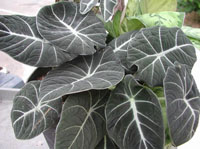Resource Library
Plant of the Week: Black Velvet Alocasia
The University of Arkansas System Division of Agriculture does not promote, support or recommend plants featured in "Plant of the Week." Please consult your local Extension office for plants suitable for your region.
Plant of the Week
Black Velvet Alocasia
Latin: Alocasia reginula

Black-leaved plants have always intrigued me, probably because of some deep-seated emotional attachment to my first car, but that’s another story. One of the blackest plants I know is a houseplant belonging to the philodendron family called Black Velvet Alocasia (Alocasia reginula). The leaves look more like a lump of charcoal than a plant.
Black Velvet alocasia is one of several species of alocasias native in Southeast Asia, with this plant probably coming from the jungles of Borneo. It and its kin were collected during the 1860s by English plant collectors who scoured the jungles of the world looking for new orchids and houseplants.
Unlike most alocasia, Black Velvet forms a branched, rhizomatous stem that can produce plants up to 18 inches wide. It’s usually less than a foot high. The thick, but brittle leaves are heart-shaped ovals about the size of a saucer. The leaf blade is a velvety black offset by platinum colored veins. The undersurface of the leaf is purplish.
To understand how a plant can be black, first me need to consider what makes the typical plant green. The run of the mill plant is green because the middle portion of the visible light spectrum - the green and yellow portion - is not used by the plant but instead reflected back to our eye. Chlorophyll uses the red and blue end of the visible spectrum in photosynthesis and casts off that portion of the spectrum not needed.
Physicists like to talk about black holes in space, concentrations of matter so dense that not even electromagnetic waves escape their tremendous gravitational pull. Black-leafed plants are living black holes in that they absorb light energy across the visible spectra, allowing none to be reflected back. Alternatively, the white veins of Black Velvet alocasia reflect almost all of the visible spectra producing the black on white contrast of the plant.
This physical reality is easy to illustrate. Compare the temperature inside a black car and a white car in the Arkansas summertime. The somewhat cooler white car is cooler because more of the spectrum is being reflected back while the black car absorbs the energy and converts it to heat.
But this velvety blackness is just an illusion, for if you crush the leaf, the familiar green of chlorophyll issues forth. In their low-light environment black-leaved plants must have made the evolutionary assumption that all light energy is good, thus hoarding light rays like McScrooge hoarded his wealth in the cartoon classics of my youth.
Black Velvet alocasia has moved from the obscurity of the plant collector to mainstream status because of the alchemy of the plant tissue culture specialists. Tissue culture labs have learned how to propagate this species en mass, thus making liners available to greenhouse growers across the nation. Plants are now showing up in better nurseries plus some of the mass market outlets.
In the home, Black Velvet alocasia should be given bright conditions but not direct sun. A north or east-facing window is ideal but any location suitable for an African violet should work. The plant is somewhat slow growing, so acquire as large a plant as possible.
Transplant the plant about once a year, but keep the pot size as small as possible. It’s not a heavy feeder so avoid the temptation of trying to force it to grow fast by extra fertilization. Like most members of the philodendron family, never let the plant sit in standing water.
By: Gerald Klingaman, retired
Extension Horticulturist - Ornamentals
Extension News - August 23, 2002
The University of Arkansas System Division of Agriculture does not maintain lists of retail outlets where these plants can be purchased. Please check your local nursery or other retail outlets to ask about the availability of these plants for your growing area.